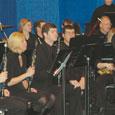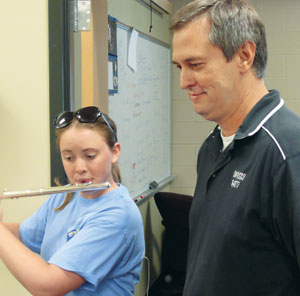 Most band directors enter the profession because they have a passion for instrumental music and for musical excellence. Teaching music is such a difficult, complex task that many professionals continue to educate themselves by seeking out and emulating directors whose ensembles are exemplary, both as concert bands and marching bands.
Most band directors enter the profession because they have a passion for instrumental music and for musical excellence. Teaching music is such a difficult, complex task that many professionals continue to educate themselves by seeking out and emulating directors whose ensembles are exemplary, both as concert bands and marching bands.
Recently I contacted five directors with outstanding programs to learn more about the daily warm-up routines that contribute to their success. Their ensembles have been invited to perform at the Midwest Clinic, reaching the finals competition at the Bands of America National Championships, and being selected to perform in major parades, such as Macy’s Thanksgiving Parade or the Rose Bowl. A detailed look at the daily routines of these veterans could help all directors achieve higher levels of excellence with their ensembles.
Daily Warm-Up Procedures
Tom Shine (Duncanville, Texas) 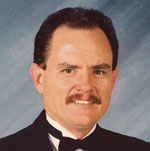
With several bands in our program, the warm-up period based is on time and ability. The top two bands meet for 85 minutes daily and warm up for 20-25 minutes on fundamentals, while the third and fourth bands meet for 55 minutes each and warm up for about 15 minutes. The students play a series of long-tone exercises based on F concert, for about 10-12 minutes a day, developed by Eddie Green at the University of Houston.
The first exercise of each warm-up is an F scale in descending whole notes (F-E, E-D, etc.). We might try the exercise with the woodwinds and brass just playing normally, or the brass could buzz with the mouthpiece. Depending on my rehearsal plans, we might use mutes in the warm-up. The goal is to make students sound the same on every note with matching volume and timbre.
I remind students that the acoustical properties of an instrument should not dictate the sound. I make comments along the way, telling students to listen to the interval and match color as they move from note to note.
For another variation I divide students into two groups. I then ask one group to sustain an F concert pitch while the second group plays up the scale for an octave. They sustain the pitches in whole notes and then in half notes, tuning intervals against the pedal. Next, we will play a series of intervals (3rds, 4ths, and 5ths) going around the room from the lowest range instruments to the highest, maintaining the interval with the same volume and color. I ask students to think about whether the sound was brighter or their embouchures too tight, with the goal of getting them to think about sound production.
Alfred Watkins (Lassiter, Georgia)
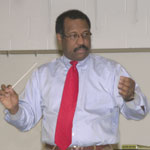 I take a private lesson approach to teaching full rehearsals, working on as many fundamental concepts as possible in a series of efficient exercises. Warming up can take as little as 10% of a rehearsal on one day, while on other days it may fill the entire period. Typically, the warm-up takes between 40% and 60% of the rehearsal. I divide our preparation for a major performance into three or four sections. Early in the cycle, rehearsals focus on fundamentals over literature in a 60/40 ratio. This changes to 50/50 in the next period and then 30/70. During the week of a performance I spend 90% of the time refining the literature.
I take a private lesson approach to teaching full rehearsals, working on as many fundamental concepts as possible in a series of efficient exercises. Warming up can take as little as 10% of a rehearsal on one day, while on other days it may fill the entire period. Typically, the warm-up takes between 40% and 60% of the rehearsal. I divide our preparation for a major performance into three or four sections. Early in the cycle, rehearsals focus on fundamentals over literature in a 60/40 ratio. This changes to 50/50 in the next period and then 30/70. During the week of a performance I spend 90% of the time refining the literature.
In daily rehearsals I assume that if we don’t cover a particular fundamental during our warm-ups, students will not cover it at all that day. It is necessary to address tone, blend, control, centered pitch, attacks, and precision every day. I continue to listen for these basics regardless of which band is rehearsing.
The warm-up begins with breathing exercises that are not too difficult. Then, we play an F concert pitch four to six times for four to eight counts each. At this stage students just blow without comments from me. I have found it a nuisance to correct every sound they make, so I just let them blow first.
Next, we play long tone exercises, such as the Remington studies, as well as long tones in scales, arpeggios, and interval studies. My goal is to play a lot of unison tones, so students focus on one concept at a time, in this case tone production and control. We continue with flexibility exercises, such as lip slurs for the brass and scale passages for the woodwinds and percussion. Octave exercises, overtones, or register slurs (interval of a 12th) for the clarinets may also be included.
I only comment between exercises, not while students are playing, making quick corrections that will apply to the next attempt. Students may play a whole note tied to a quarter, and then rest for three counts. A metronome keeps the pulse during the exercises.
The next area is lyrical playing – phrasing, sense of line, and pitch; I particularly focus on understanding the pitch tendencies of various instruments. After that we work on such techniques as articulation variations, lengths of tones, and balance and blend using chorales and chordal playing. These are always played molto tenuto or molto legato, and we work on just tuning (adjusting 3rds and 5ths of chords). Range extension exercises help students establish good intonation at extreme ranges by playing scales in various keys and expanding to multiple octaves when possible.
Throughout these exercises we alternate frequently between singing and playing. In a unison or chordal exercise students may play the tones and then sing them, adjusting intervals according to just tuning, and then they play the exercise a second time. I am always seeking exercises that teach several different skills at once.
Chuck Campbell (North Hardin, Kentucky)
A good warm-up starts with perfection in the rehearsal room. When students enter the classroom, I have everything written on the board, such as needed materials for the rehearsal and scheduled exercises. So there are no questions about what is to happen. I always have a yellow notepad on the podium, which keeps me engaged with students instead of looking back at the board.
I step on the podium at the same time every day – two minutes after the bell has rung. Once the band is seated, students who are late have to wait until I give them permission to sit down. It is important for students to develop respect for rehearsal procedures and each other.
As we begin warming up the focus is on developing a transparent ensemble sound. This stems from the influence of Robert Hawkins of Morehead State University, who was my musical father figure. The goal is that if you stand back and close your eyes, you can find each instrument, hear the different colors in the ensemble and the clarity.
We also use exercises and method books to learn the major and minor scales, technique, articulation, rhythmic patterns, and basic musicianship. At least 20 minutes of an 80 minute rehearsal is for warming up, which ensure that students are mentally and physically ready to start. About a month before a festival, I add sightreading to the daily routine.
David Gorham (Owasso, Oklahoma)
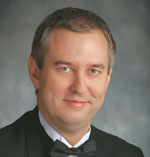 Warm-ups take more time early in the season and decrease as contest approaches. The younger bands meet daily for 55 minutes and use about 2/3 of that time to work on fundamentals. The older students require less time on the basics. We begin with breathing exercises every day, basically playing for four counts, pausing for twelve, then playing for four and stopping for eight. As students play they focus on maintaining steady even air. We usually work on breathing while standing so students can feel the movement of the rib cage with their hands. Next, we usually play an F concert scale, but sometimes this will change depending on which pieces we are rehearsing that day.
Warm-ups take more time early in the season and decrease as contest approaches. The younger bands meet daily for 55 minutes and use about 2/3 of that time to work on fundamentals. The older students require less time on the basics. We begin with breathing exercises every day, basically playing for four counts, pausing for twelve, then playing for four and stopping for eight. As students play they focus on maintaining steady even air. We usually work on breathing while standing so students can feel the movement of the rib cage with their hands. Next, we usually play an F concert scale, but sometimes this will change depending on which pieces we are rehearsing that day.
A Bach chorale is next (usually #12 from 16 Bach Chorales). After the ensemble plays the first eight bars, we may take one voice at a time for to hear the various parts (SATB). This gives each player and section a chance to tune before putting the parts back together. We follow this approach religiously.
Phillip Geiger (Westfield, Texas) 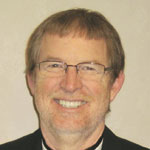
I have continued to refine my approach to warm-ups over the years. Now, I act if the warm-up starts the moment students walk through the door. Depending on the age of the students, I create exercises that help them focus on the physical aspects of playing. I generally spend about a quarter of an hour rehearsal on warm-ups, but the time varies depending on upcoming performances, the time of year, and the difficulties in the concert music. I could warm-up for as little as three minutes, but sometimes I use the entire class period for this.
Many young directors simply copy exercises they have learned without thinking about what they intended to accomplish. For example, a breathing exercise includes work on moving the air and controlling the tone; it is much more than simply holding a note for 16 counts. I carefully match the exercises to what I want to teach. Once students sit down, they perform some type of breathing exercise to develop fundamental tone and put them in the frame of mind to rehearse.
After the breathing exercise, students to play a bit on their own to make sure the instrument is working properly. I may stop them to ask if they are applying what they did in the breathing exercise to what they are playing. Depending on rehearsal time, we play a set of variations to cover the same musical goals from different perspectives. We might play a descending tone exercise starting on F major and moving chromatically or scales exercises. I give comments at the end of each exercise and ask frequent questions about what the students hear. The variations change from day to day, giving students different experiences.
After working on breathing and tone, we may work on articulation, including the physical aspects of starting the note and the syllable used to start the sound. When I teach I like to get off the podium and move around. Hand signals and facial expressions encourage students to pay attention. Through frequent questioning I hope students discover that information that applies to a trumpet player may also apply to a flute player. The goal is for them to think this way as we rehearse our concert literature.
Preferred Warm-Up Materials
Tom Shine: We use few outside books, and students memorize most of the fundamental exercises. I like section 9 of the Fussell book (Exercises for Ensemble Drill, 1934) to develop sightreading skills and Clarke #3 (Characteristic Studies for Trumpet 1912) to develop finger dexterity. We occasionally play a page out of the Tipps for Band book (1959) to work at different speeds for technique and facility.
Alfred Watkins: We use the Curnow Tone Studies for Band (1995) in lieu of chorales and mostly play the unisons from there. This allows work on various sounds. When we play chorales, we use Three Bach Chorales (arr. Eller, 1963) and also the Claude Smith Symphonic Warmups for Band (1982) for chorales and technical exercises that improve sightreading. The William White Unisonal Scales and Chords and Rhythmic Studies (1921) help to build Warm-Ups, technique and the Grover Yaus 40 Rhythmical Studies (1958) for rhythmic development. Our younger bands also use Essential Elements series (1991) and 14 Weeks to a Better Band for sightreading development.
Chuck Campbell: We use the Fussell book daily. For improving sightreading skills, we use the Yaus 101 Rhythmical Rest Patterns (Alfred, 1953) and also Sixteen Bach Chorales arranged by Lake (Hal Leonard, 1934). We also use the Curnow Tone Studies for upper band and Tone Builders with developing groups. Eighty percent of the time I use both the Curnow and chorales. I don’t there is a day that goes by that I wouldn’t use at least one of them in some form. The Bach chorales have a completely different sound from Curnow’s tone exercises, which have more contemporary sound. I have also used the Tipps for Band book and the Claude Smith Symphonic Warmups (Hal Leonard, 1982) for learning scales and rhythmic reading.
David Gorham: I don’t use method books. The band generally plays about eight bars of a chorale from Sixteen Bach Chorales, then we sing the chorale and play it again. Several sightreading books that have been useful include the Charles Forque Harmonized Rhythms (1994), Jerry West’s The Sightreading Book (2006), and several march books such as the Bennett Band Book (1923). Lately I have students play by ear more frequently. I might have them play “Twinkle, Twinkle” while looking at scale degrees (1…1…5…5…6…6…5 etc.) Then we change to a different key and play it again. This then relates back to the chorale. Students think about which scale degree they are playing and transpose that to another key.
Phillip Geiger: I use just a couple of phrases from any chorale that allows us to focus on fundamentals. The chorale cannot have any large intervals or difficult keys. Then students are encouraged to reach what my ear hears and to develop their own ears.
The Aim of Warm-Ups
Tom Shine: Students focus on matching tones and producing a steady sound without any motion in the embouchure or musculature. We talk about maintaining a still embouchure, playing a brick-shaped note, and making sure that shape does not change from note to note. One key to that consistency is daily work on articulation exercises. We will address the basic subdivisions of the whole note: four connected quarter notes, then four separated, eight eighths with the same articulations, four groups of triplets both connected and separated, and four groups of 16ths.
We’ll play these at about 95 beats per minute and end with a whole note. Students are not supposed to breathe between the subdivision or vary the tempo. If the literature we are preparing requires double tonguing, we will practice single-tonguing up to a tempo of 120 and double-tonguing to 165 with four 16ths and a quarter per pitch. All through our work, I talk about developing better listening skills and focus.
Alfred Watkins: I review as many musical concepts as possible in warm-ups – sound, articulation, rhythmic precision, balance, and blend. Chorales work well to teach various styles. Our playing might use a neoclassical style with the same sound from the beginning, middle, and end or each note. At other times we play with in a Romantic style and change timbre and tone or changing the instrumental weight on the tones. I try to stay in the middle of instrument range and dynamics and also spend time on inherent pitch problems with each instrument.
To develop an extended range, we will play at a moderate tempo and allow performers to hear the changes in timbre. We talk about maintaining a centered tone in extreme registers. Once a week students sing a unison scale together and then have different groups sustain the root, 3rd, 5th, or 7th of the scale so they develop a strong sense of pitch and balance. These exercises are always played in easier keys so students aren’t fighting the instruments.
Chuck Campbell:: Every day we play some type of chorale for tone and a scale study for technique. These elements are essential, and every rehearsal is built on a long tone study and a scale study. I also use modeling frequently by having a strong student play a scale as a solo and then asking the class what they liked or disliked in what they hear. Then the entire groups tries to match what they have heard.
We also play a memorized chord to work on balance and changing voicing. The ensemble plays the chord until it locks in and then we might move up or down by half step. I strongly believe in making students analyze the sound and make changes. Tone is a predominant concept in everything we do as musicians.
David Gorham: The concepts covered in warm-ups vary based on the music we are performing for the next concert. We may focus on a particular rhythmic pattern, style, scales, or rhythms found in our concert music. The warm-up is designed to instill confidence and often this is more important than mastering a particular skill. I frequently remind students “Don’t phone it in. There’s a purpose to this.” I want them to stay engaged and listening closely at all times.
Phillip Geiger: It is incredibly important that all students recognize that instructions given to one section apply to everyone in the room. I emphasize this in warm-ups and expect students to stay alert at all times in rehearsals. We may cover 100 different things in a 20-minute warm-up, but the goal is always to move the ensemble closer to the sound I have in my head. If the musical fundamentals sound bad and do not improve over time, the director is not helping the ensemble produce a better sound. We are always striving for a new level of musical expression, and this is true whether we are playing Grade 1 or Grade 5 music.
There is much we can learn from studying the daily routines of these five exemplary band directors and their bands; however, good music education requires more than simply including the exercises of the routine as part of rehearsals and then expecting to hear a great outcome – after all, the music does not teach the band; the teacher teaches the band. A great band has a good musician on the podium, someone who has a mental concept of a good band sound, knowledge of the sound of each instrument’s characteristic tone, and a good concept of balance.
It follows that the director is thoughtful, thorough, and persistent in the approach to rehearsals; and strongly believes in a daily routine that teaches music fundamentals at the highest possible level as a way to a better-sounding band. Music may be one of the most difficult subjects to teach, but it is also one of the most worthwhile, rewarding professions I know. It is through teaching that instructors learn more about themselves, the students they teach, and the great art of music-making
